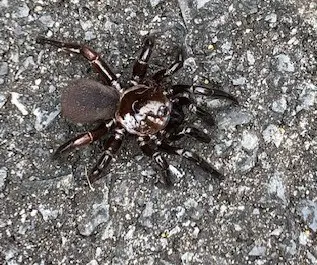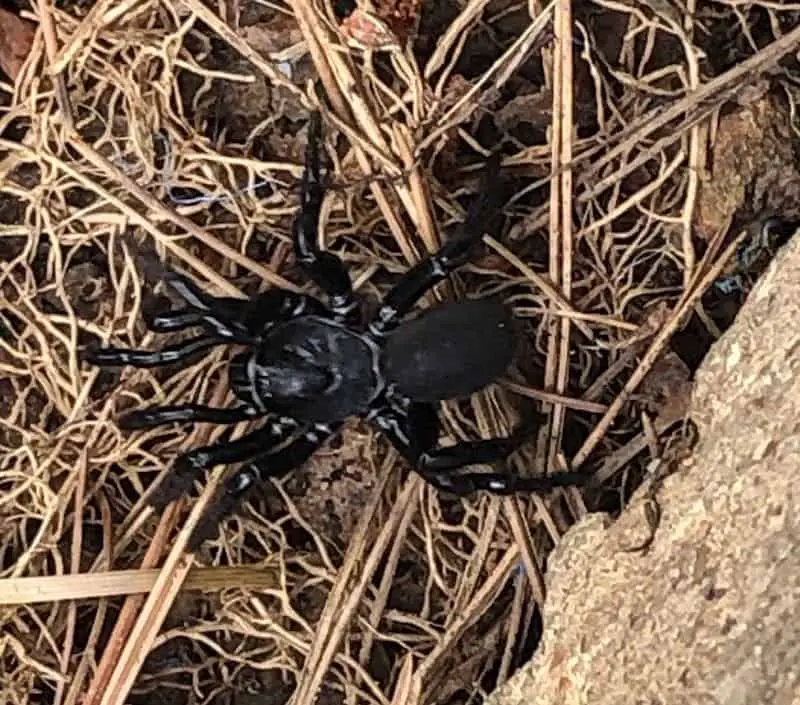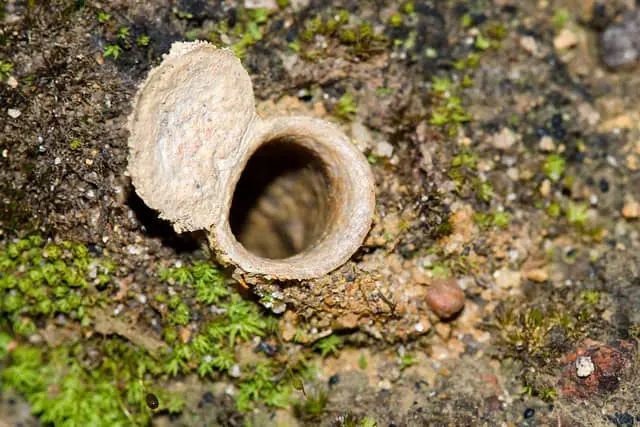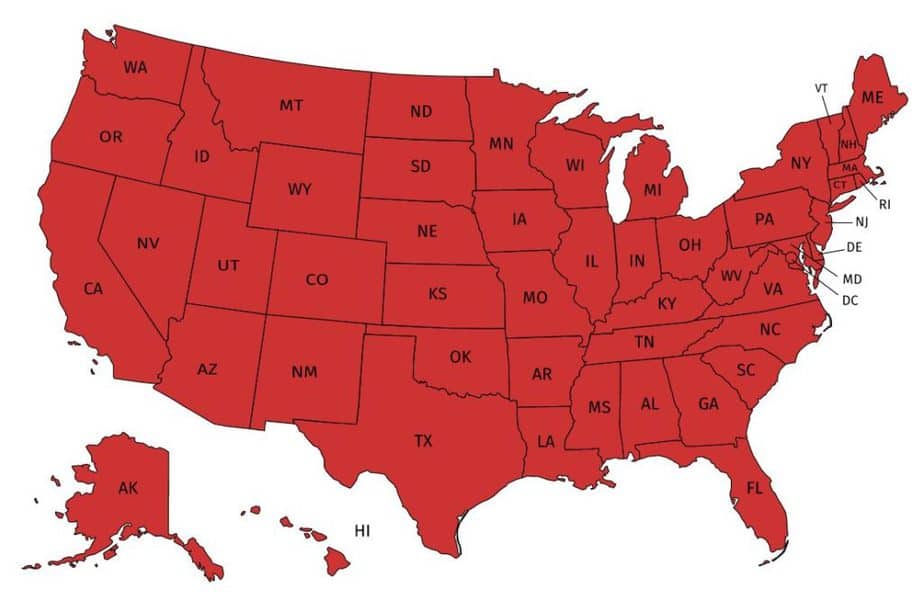Ummidia is a genus of spiders that can be found around the world. Among other genus, they are commonly called trapdoor spiders because they build underground tunnels that are secured with a trap-door.
Ummidia Spider Description
The color of Ummidia spiders ranges from very dark brown to a lighter reddish brown. Their cephalothorax is shiny and hard while their abdomen is usually brighter and hairy. They are fast runners and have two large fangs to catch prey. For humans, their bites aren’t usually dangerous. Ummidia spiders are often confused with the medically significant Australian funnel web spider that is native to, as the name suggests, Australia. So if you come across what appears to be a funnel web spider in the U.S., you are almost certainly looking at a non-aggressive and non-threatening ummidia trap-door spider.

Size
On average, an Ummidia spider reaches a body size of around 1 inch. However, some specimen can grow up to a size of 1.6 inches.

Web
As mentioned above, trapdoor spiders do not create a web like other spiders. They build underground tunnels and secure the entrance to it with a door that can be closed with a hinge. The trapdoor is made of the spider’s silk material.

Bite
Trapdoor spiders are not aggressive spiders and usually run away into the underground before any human can get close to them. In the rare cases in which a bite occurs, they are only mildly painful and not dangerous.
Ummidia scientific classification
- Kingdom: Animalia
- Phylum: Arthropoda
- Subphylum: Chelicerata
- Class: Arachnida
- Order: Araneae
- Infraorder: Mygalomorphae
- Family: Halonoproctidae
- Genus: Ummidia
Ummidia Distribution in the US

There are several species of Ummidia that can be found throughout the entire world. Therefore, Ummidia trap-door spiders can be found in every US state: Alabama, Alaska, Arizona, Arkansas, California, Colorado, Connecticut, Delaware, Florida, Georgia, Hawaii, Idaho, Illinois, Indiana, Iowa, Kansas, Kentucky, Louisiana, Maine, Maryland, Massachusetts, Michigan, Minnesota, Mississippi, Missouri, Montana, Nebraska, Nevada, New Hampshire, New Jersey, New Mexico, New York, North Carolina, North Dakota, Ohio, Oklahoma, Oregon, Pennsylvania, Rhode Island, South Carolina, South Dakota, Tennessee, Texas, Utah, Vermont, Virginia, Washington, West Virginia, Wisconsin, Wyoming


I think I found one of these today, buried underground.
Black, body approx. .5 inch in size. Hair on legs and abdomen but shiny on other part of body. Found in Spokane WA near a landscaped rock wall in May.
Hi Amanda,
Thank you for the photo. This is some type of trapdoor spider (family Halonoproctidae). There are a lot of species that have a very similar appearance so an exact identification is only possibly under the microscope.
It is definitely not medically significant. You can find some more information about the on this overview about trapdoor spiders here:
https://usaspiders.com/ummidia-trap-door-spider
What type of spider this
Found in Central Ohio.
Hello Alex, thanks for getting in touch! This is most likely some type of trapdoor spider. Possibly Ummidia audouini, a cork trapdoor spider. All trapdoor spiders found in the U.S. are not medically significant: https://usaspiders.com/ummidia-trap-door-spider/
Medium size black spider. Shiny. Not hairy. Not a jumping spider. Found In my backyard in Chesterfield Virginia.
Hello Katherine, thanks for uploading this picture! This is most likely some type of trapdoor spider. Possibly Ummidia audouini, a cork trapdoor spider. All trapdoor spiders found in the U.S. are not medically significant: https://usaspiders.com/ummidia-trap-door-spider/
I assume this guy is a trapdoor spider. However not like others I have found around the house here in Oklahoma. Trapdoor spiders I am used too finding have a charcoal colored rear. Any thoughts?
Hello Billy, yes, the image was uploaded successfully! Sometimes it takes some time to actually show up on the site due to browser caching. Trapdoor spiders some in a range of colors from entirely black to gray, or reddish. My guess is that this might be a Ummidia aoudini.
Found in Missouri 7/14/21
Can’t seem to identify this spider we saw at Kayak Point, near Camano Island in Washington state.
Was just in the hiking trail, no web nearby that we could see.
Hello Aletheia, thanks for getting in touch! This mean-looking fellow is some type of trapdoor spider. Possibly in the genus Ummidia: https://usaspiders.com/ummidia-trap-door-spider/
Is this a trap door spider? Elloree, South Carolina
Hello Marykay, thanks for getting in touch! Yes, this is a trapdoor spider.
I’m not sure if this is a trapdoor, we found it dead on our patio. We live in eastern Washington state. Please let me know what you think. I’ve lived here my whole life and have never seen anything like this.
Hello Stephanie, thanks for getting in touch! I am fairly certain that this is some type of trapdoor spider. It is (or was) definitely not medically significant.
Hi, never seen one like this, looks like a trapdoor of some sort. Sebastopol, California
What are they?
Hello Ptravis, thanks for getting in touch! They are mygalomorph trapdoor spiders – possibly in the genus Ummidia: https://usaspiders.com/ummidia-trap-door-spider/
They are not medically significant.
Spider found in kitchen of home.
1. Spider was large, about 2-1/2 inches with legs spread out. Body almost 1 inch, I think. Shiny black legs with some hairs. Very long “palps” (?)–makes it look like it has 10 legs. Slow moving indoors, but when I released it outside scampered away quickly.
2. Poway, CA (San Diego County)
3. RFisher
Hello Ron, thanks for getting in touch! This is some type of mygalomorph trapdoor spider, possibly in the genus Ummidia. None of the trapdoor spiders found in the U.S. are medically significant.
Here is a picture of an Ummidia sp. with similarly long pedipalps: https://bugguide.net/node/view/783649
Here is more information about trapdoor spiders: https://usaspiders.com/ummidia-trap-door-spider/
Found this guy in the freezing cold in my driveway on the way to warm the car to take my boy to school, brought him in got him a lamp and getting crickets before work if I can he was so cold he could barely move so till it gets warm lazo short for Lazarus will be here with me just wanted to share him and get any suggestions to make his stay comfortable !
This one was found in East Tennessee
We found this spider crawling around in the grass in Byrdstown Tennessee. Middle Tennessee near the Kentucky border at the edge of the woods near a lake.
Hi Lea, this is a trapdoor spider of the genus Ummidia: https://usaspiders.com/steatoda-grossa-false-widow-spider/
Caught a trap door spyder in S Central Ky in the yard. He was walking in the open early in the morning quite slowly, and i thought he may be related to a tarantula with the way he looks. He was very non aggressive and cool!
Please identify this spider found in Georgia
Hi Damon, this is a trapdoor spider of the genus Ummidia: https://usaspiders.com/ummidia-trap-door-spider/
Black Purseweb Spider (Sphodros niger)
I was just researching these!
I hope I’m not losing it, but this looks like a spider who was living on my ceiling in my living room. He stuck around a long time and then just disappeared. Do trapdoor spiders do things like that? He never spun a web, but did hang from some silk from time to time. He looked EXACTLY like these photos. I had never seen a spider like this before. I found this one (could have been his twin brother) dead outside under our carport.
I hope I’m not losing it, but I had a spider living on my ceiling for weeks who looked EXACTLY like these. Do trapdoor spiders live in crevices as well as burrows? He finally disappeared. He spun no web but did enjoy suspending himself from a silk from time to time. I found his twin brother (dead unfortunately – not-so-great photo follows) You can clearly see his fangs but not much else. His body was roughly the size of a nickle and his abdomen was the dull black you see in the photos.
I hope I’m not losing it, but I had a spider living on my ceiling for weeks who looked EXACTLY like these. Do trapdoor spiders live in crevices as well as burrows? He finally disappeared. He spun no web but did enjoy suspending himself from a silk from time to time. I found his twin brother (dead unfortunately) You could clearly see his fangs. His body was roughly the size of a nickle and his abdomen was the dull black you see in the photos.
Found this crawling outside my house. It was fairly large (around an inch long). Think it might be a trapdoor spider, thoughts?
Found while gardening in the underbrush. I’m sure I recall seeing these in my youth.
They dwelled in sticky, erratic, especially white webs without much funnelweb similarity, if any. They emerged slowly from the deep recesses of the web which were always out of view.
Thank you in advance for your time and expertise in your assisting my efforts of identification. I’ve searched for some some time, and the only similar spiders I see are from the genus Ummidia. But I’m sure I’ve seen this species in the webs I’ve described.
Thank you,
Harvey
Hi Harvey, this is definitely a mygalomorph trapdoor spider. I can’t say what genus or even family it is. Your location in the U.S. would help narrow it down. It could be Ummidia sp.